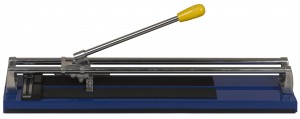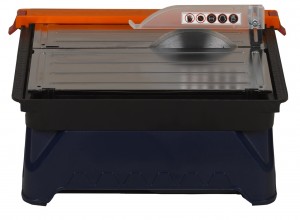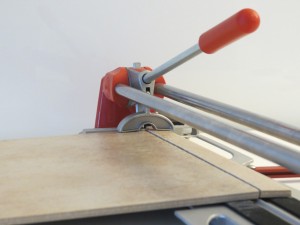Buying a tile cutter
Buying a tile cutter is a necessary undertaking for any DIY tiling project. The main issue is deciding whether to go with an electric option, a traditional unpowered manual tile cutter, or indeed both. My recommendations at the bottom of this guide have changed slightly recently because of an incredibly good experience with a tile cutter which I think is easily the best value tile cutter I’ve ever used. However, before I get to my tile cutter choices, first a little more about the types available.
Types of tile cutter
For me, there are just two types of tile cutter that you actually need for the vast majority of tiling jobs – a manual score and snap cutter, and an electric tile cutter. There are indeed a couple of other tile cutting options – tile scorers and tile nibblers – they both work, but I find them hard work, and so I’ve never felt they are essential parts of a tiler’s toolkit. Instead, I’ve only ever needed the two types of tile cutter shown below.
Score and snap tile cutters or manual tile cutters

Manual, or score and snap tile cutters, will deal with the vast majority of your tiling cutting requirements.
Manual tile cutters are unpowered and can only cut a straight line, and that line will always have to extend all the way across the tile. In other words you score a line on the tile, and snap the tile into two pieces.
You can get hand held varieties that look a bit like a pair of pliers, but these certainly have a limited capacity to cut, so I’d always opt for the larger type shown to the right, where guide rails keep the scoring wheel in a straight line, and snapping the tile is a simple case of using the handle to apply pressure down, and on either side of the scored line to break the tile in two.
Electric tile cutters

Electric tile cutters or tile saws allow you to cut partially across a tile so you have the ability to make intricate cuts.
Electric tile cutters, as the name suggests, are powered and sometimes called tile saws or wet tile saws.
Electric tile cutters can also cut in a straight line, just like a score and snap cutter, but you can also cut part the way across a tile. Therefore it means you can cut fiddly shapes that are sometimes required, such as around the base of a door frame for example.
Another example would be cutting around socket outlets on a kitchen splashback, where you need to cut a portion out of the corner of tiles in order to tile around the socket.
Which tile cutter?
So which tile cutter do you choose? If you only need straight cuts, then without a doubt, just get a manual tile cutter because you just don’t need anything else. True, you can do it all with an electric cutter, but the drawbacks that people often don’t realise are:-
- They make a noise like you wouldn’t believe.
- Most electric cutters are ‘wet’ in that you need to fill a water reservoir under the cutter to cool the blade. This means you normally get covered in water when you make a cut. Fine for one or two cuts – boring for a hundred.
- A certain amount of skill is needed to feed the tile through the blade to make accurate straight cuts.
- Takes much longer to make a cut than with the hand operated option.
My tile cutter choices

The Rubi Star 50N Plus will trim slivers off even the hardest porcelain tiles which is why I think it’s one of the best tile cutters on the market. These porcelain tiles were 8mm thick, but I think it would certainly be able to handle thicker!
I’ve always been a fan of Rubi tile cutters, but after recently test driving the Rubi Star 50N Plus tile cutter, I am now their biggest fan. Ceramic tiles are a breeze to cut with this tool, but more significantly I found it just as easy to cut 8mm thick porcelain tiles. My previous ‘favourite’ score and snap tile cutter was into three figures, but as you’ll see below, the Rubi Star is well below the £100 mark.
The Rubi 50N plus because can certainly deal with cutting a decent size of tile – maximum size being 51cm. However you can actually opt for the smaller 40N if you’re sure you don’t need such a large capacity, or if you need bigger, there is also a 60N model. The Rubi’s can be found on Amazon, as well as outlets such as Screwfix and Walls and Floors.
As for the electric option, Vitrex now have a tile saw that can be bought for below £50, and again, it will also deal with porcelain tiles. Just check out the Amazon reviews!
